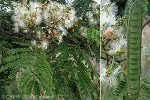Cook Islands Biodiversity Database
Species Page
Falcataria moluccana
‘ĀrapitiaAlbizia
Multimedia & Additional Resources
| Type | Description | Download |
| Leaves, flowers and fruit | 79KB |
General Information
Cook Islands Distribution
| Southern Group: Present Makatea: Present | ||||||||
RR |
MG |
AT |
MK |
MT |
AK |
PL |
TK |
MN |
++++ |
++++ |
++++ |
++? |
- |
+++ |
- |
- |
- |
| Northern Group: - | |||||
TN |
MH |
RK |
PK |
NS |
SW |
- |
- |
- |
- |
- |
- |
Scientific Taxonomy
Falcataria moluccana (Miq.)
SYNONYMS: Adenanthera falcataria [O]; Albizia falcataria; Albizia falcata [sensu]; Albizia moluccana [sensu]; Adenanthera falcataria; Paraserianthes falcataria [Filippo del Albizzi was an Italian naturalist who cultivated a member of this genus in 1749. His name was latinized as Albizia, and this remains as the correct botanical spelling.]
TAXONOMY: PLANTAE; ANTHOPHYTA (=Angiospermae); MAGNOLIOPSIDA (=Dicotyledones); ROSIDAE; Fabales (Legumes); MIMOSACEAE
More Information
SIGNIFICANCE NOTES -
POSITIVE SIGNIFICANCE: Forestry
NEGATIVE SIGNIFICANCE: Invasive - moderate, Weed - serious. Comments: A moderate invasive tree in the valleys and fernland slopes of inland Rarotonga. Not actually invasive in the established inland forests. On most islands it spreads rapidly onto horticultural areas, and it requires constant control.
IDENTIFICATION: A tall spreading and layered tree, to 25m. LEAVES alternate, overall to 40x20cm, compound, stalk to 12cm with large dorsal nectary; pinnae to 20 pairs, each to 12cm. LEAFLETS opposite, to 25 pairs, each 20x6mm, sub-parallel sides, tip sharp off-centre. FLOWERS branching cluster, each a silken pompom of white filaments (=stamens), 3.5cmØ. FRUIT pod, flat, straight, 12x2cm, ~15 seeds. SEEDS flattened, oval, 6x3mm.
Vouchers & References
Vouchers:
Rarotonga: report, seeds from Fiji in 1937 to Department of Agriculture, some planted at Avarua School and were milled in 1960, CI Review (Feb 1960) 6(2) p.6, G.McCormack 11/2005
References:
p.690 Wagner et al.- Flowering Plants of Hawaii
p.404 Neal - In Gardens of Hawaii
p.3/077 A.C.Smith - Flora Vitiensis Nova
p.357f Whistler - Ethnobotany of the Cook Islands
p.98 McCormack/Kunzle - Rarotonga's Mountain Tracks and Plants
Data Update History (information):
zTX, zB02, zM02, zD02
Web Resources
Citation Information
McCormack, Gerald (2007) Cook Islands Biodiversity Database, Version 2007.2. Cook Islands Natural Heritage Trust, Rarotonga. Online at http://cookislands.bishopmuseum.org. ![]()
Please refer to our use policy.

